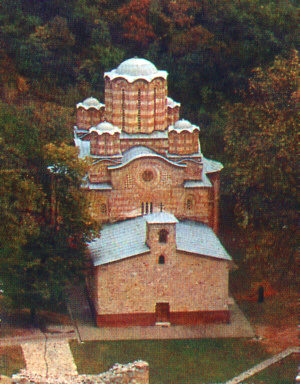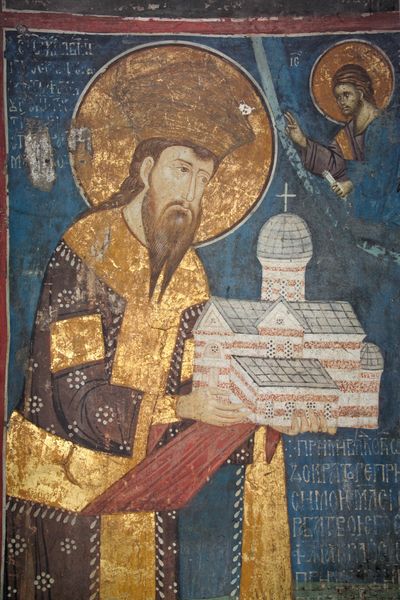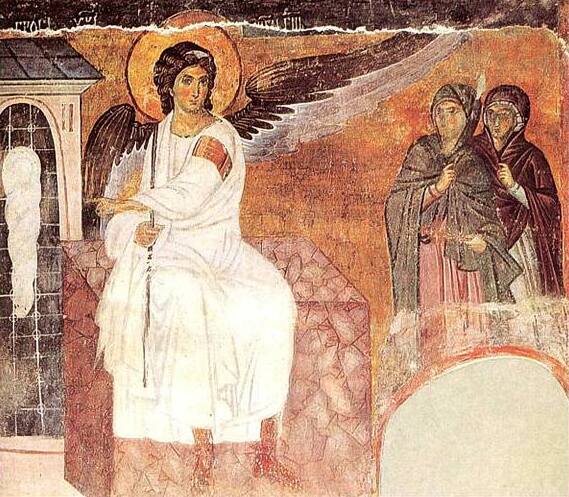|
Ravanica Monastery
The Ravanica Monastery ( sr, / ) is a Serbian Orthodox monastery on Kučaj mountains near Senje, a village in Ćuprija municipality in Central Serbia. It was built in 1375–1377 as an endowment of prince Lazar of Serbia, who is buried there. The Ravanica church is called the birthplace of the new artistic movement "Morava school" because of architectural and artistic features. It is original blend of the Mount Athos and the cross-in-square five-domed model that became standard in the time of King Milutin. Ravanica was declared Monument of Culture of Exceptional Importance in 1979, and it is protected by Republic of Serbia. History Built between 1375 and 1377, Ravanica is the famous endowment of Prince Lazar, where he was buried after his death in the Kosovo battle. Since then, Ravanica has been a pilgrim's destination and an important center of cultural activities & assemblies for the Serbian people. The monastery was assaulted and damaged by the Ottoman Turks several ti ... [...More Info...] [...Related Items...] OR: [Wikipedia] [Google] [Baidu] |
Vrdnik-Ravanica Monastery
The Vrdnik-Ravanica Monastery ( sr, Манастир Врдник-Раваница, Manastir Vrdnik-Ravanica), also known as Little Ravanica (Мала Раваница'' / Mala Ravanica''), is a Serbian Orthodox monastery in Vrdnik in the Fruška Gora mountains in the northern Serbia, in the province of Vojvodina. The exact date of its founding is unknown. The records indicate that the church was built at the time of Metropolitan Serafim Jovanović, in the second half of the 16th century. The present church in the monastery was constructed in the period from 1801 to 1811. The icons on the altar screen and the vaults were painted by Dimitrije Avramović in 1853. Vrdnik-Ravanica Monastery was declared Monuments of Culture of Exceptional Importance (Serbia), Monument of Culture of Exceptional Importance in 1990, and it is protected by Republic of Serbia. See alsoMonasteries of Fruška Gora- Fruškać *Monuments of Culture of Exceptional Importance (Serbia), Monument of Culture of Exc ... [...More Info...] [...Related Items...] OR: [Wikipedia] [Google] [Baidu] |
Narthex
The narthex is an architectural element typical of early Christian and Byzantine basilicas and churches consisting of the entrance or lobby area, located at the west end of the nave, opposite the church's main altar. Traditionally the narthex was a part of the church building, but was not considered part of the church proper. In early Christian churches the narthex was often divided into two distinct parts: an esonarthex (inner narthex) between the west wall and the body of the church proper, separated from the nave and aisles by a wall, arcade, colonnade, screen, or rail, and an external closed space, the exonarthex (outer narthex), a court in front of the church facade delimited on all sides by a colonnade as in the first St. Peter's Basilica in Rome or in the Basilica of Sant'Ambrogio in Milan. The exonarthex may have been either open or enclosed with a door leading to the outside, as in the Byzantine Chora Church. By extension, the narthex can also denote a covered porch ... [...More Info...] [...Related Items...] OR: [Wikipedia] [Google] [Baidu] |
Ktitor
''Ktetor'' ( el, κτήτωρ) or ''ktitor'' (; ka, ქტიტორი ''kt’it’ori''; ro, ctitor), meaning "founder", is a title given in the Middle Ages to the provider of funds for construction or reconstruction of an Eastern Orthodox church or monastery, for the addition of icons, frescos, and other works of art. It was used in the Byzantine sphere. A Catholic equivalent of the term is "donator". At the time of founding, the ktetor often issued typika, and was illustrated on fresco Fresco (plural ''frescos'' or ''frescoes'') is a technique of mural painting executed upon freshly laid ("wet") lime plaster. Water is used as the vehicle for the dry-powder pigment to merge with the plaster, and with the setting of the plaste ...es ("ktetor portrait"). The female form is ''ktetorissa'' ( el, κτητόρισσα) or ''ktitoritsa'' (). Sources * * History of Eastern Orthodoxy Philanthropy Byzantine culture Greek words and phrases {{Orthodoxy-stub ... [...More Info...] [...Related Items...] OR: [Wikipedia] [Google] [Baidu] |
Liturgical Year
The liturgical year, also called the church year, Christian year or kalendar, consists of the cycle of liturgical seasons in Christian churches that determines when feast days, including celebrations of saints, are to be observed, and which portions of Scripture are to be read either in an annual cycle or in a cycle of several years. Distinct liturgical colours may be used in connection with different seasons of the liturgical year. The dates of the festivals vary somewhat among the different churches, although the sequence and logic is largely the same. Liturgical cycle The liturgical cycle divides the year into a series of seasons, each with their own mood, theological emphases, and modes of prayer, which can be signified by different ways of decorating churches, colours of paraments and vestments for clergy, scriptural readings, themes for preaching and even different traditions and practices often observed personally or in the home. In churches that follow the litu ... [...More Info...] [...Related Items...] OR: [Wikipedia] [Google] [Baidu] |
Adoration Of The Lamb
The ''Adoration of the Mystic Lamb'', also called the ''Ghent Altarpiece'' ( nl, De aanbidding van het Lam Gods), is a large and complex 15th-century polyptych altarpiece in St Bavo's Cathedral, Ghent, Belgium. It was begun around the mid-1420s and completed by 1432, and it is attributed to the Early Netherlandish painting, Early Netherlandish painters and brothers Hubert van Eyck, Hubert and Jan van Eyck. The altarpiece is considered a masterpiece of European art and one of the world's treasures, it was “the first major oil painting,” and it marked the transition from Middle Age to Renaissance art. The panels are organised in two vertical Register (art), registers, each with double sets of foldable wings containing inner and outer panel paintings. The upper register of the inner panels represent the heavenly redemption, and include the central classical ''Deësis'' arrangement of God (identified either as Jesus, Christ the King or God the Father), flanked by the Blessed Vir ... [...More Info...] [...Related Items...] OR: [Wikipedia] [Google] [Baidu] |
Twelve Apostles
In Christian theology and ecclesiology, the apostles, particularly the Twelve Apostles (also known as the Twelve Disciples or simply the Twelve), were the primary disciples of Jesus according to the New Testament. During the life and ministry of Jesus in the 1st century AD, the apostles were his closest followers and became the primary teachers of the gospel message of Jesus. There is also an Eastern Christian tradition derived from the Gospel of Luke of there having been as many as seventy apostles during the time of Jesus' ministry. The commissioning of the Twelve Apostles during the ministry of Jesus is described in the Synoptic Gospels. After his resurrection, Jesus sent eleven of them (as Judas Iscariot by then had died) by the Great Commission to spread his teachings to all nations. This event has been called the dispersion of the Apostles. In the Pauline epistles, Paul, although not one of the original twelve, described himself as an apostle, saying he was called b ... [...More Info...] [...Related Items...] OR: [Wikipedia] [Google] [Baidu] |
Warrior Saint
The Military Saints, Warrior Saints and Soldier Saints are patron saints, martyrs and other saints associated with the military. They were originally composed of the Early Christians who were soldiers in the Roman army during the persecution of Christians, especially the Diocletianic Persecution of AD 303–313. Most of the Early Christian military saints were soldiers of the Roman Empire who had become Christian and, after refusing to participate in Imperial cult rituals of loyalty to the Roman Emperor, were subjected to corporal punishment including torture and martyrdom. Veneration of these saints, most notably of Saint George, was reinforced in the Latin Church during the time of the Crusades. The title of " champion of Christ" (''athleta Christi'') was originally used for these saints, but in the late medieval period also conferred on contemporary rulers by the Pope. Since the Middle Ages, more saints have been added for various military-related patronages. Hagiog ... [...More Info...] [...Related Items...] OR: [Wikipedia] [Google] [Baidu] |
Fresco
Fresco (plural ''frescos'' or ''frescoes'') is a technique of mural painting executed upon freshly laid ("wet") lime plaster. Water is used as the vehicle for the dry-powder pigment to merge with the plaster, and with the setting of the plaster, the painting becomes an integral part of the wall. The word ''fresco'' ( it, affresco) is derived from the Italian adjective ''fresco'' meaning "fresh", and may thus be contrasted with fresco-secco or secco mural painting techniques, which are applied to dried plaster, to supplement painting in fresco. The fresco technique has been employed since antiquity and is closely associated with Italian Renaissance painting. The word ''fresco'' is commonly and inaccurately used in English to refer to any wall painting regardless of the plaster technology or binding medium. This, in part, contributes to a misconception that the most geographically and temporally common wall painting technology was the painting into wet lime plaster. Even in appar ... [...More Info...] [...Related Items...] OR: [Wikipedia] [Google] [Baidu] |
Sarkofag Car Lazar
''Sarkofag'' is a novel by Slovenian author Dušan Merc. It was first published in 1997. See also *List of Slovenian novels A list of Slovene novels: 0-9 * 5 do 12h A * Abadon (novel) * Alamut (1938 novel) * Angie * Aritmija (novel) * Ata je spet pijan B * Balerina, balerina * Bela dama Devinska * Bobri (novel) * Boštjanov let C * Čaj s kraljico *Camera obscura ... Slovenian novels 1997 novels {{1990s-novel-stub ... [...More Info...] [...Related Items...] OR: [Wikipedia] [Google] [Baidu] |
Anthropomorphic
Anthropomorphism is the attribution of human traits, emotions, or intentions to non-human entities. It is considered to be an innate tendency of human psychology. Personification is the related attribution of human form and characteristics to abstract concepts such as nations, emotions, and natural forces, such as seasons and weather. Both have ancient roots as storytelling and artistic devices, and most cultures have traditional fables with anthropomorphized animals as characters. People have also routinely attributed human emotions and behavioral traits to wild as well as domesticated animals. Etymology Anthropomorphism and anthropomorphization derive from the verb form ''anthropomorphize'', itself derived from the Greek ''ánthrōpos'' (, "human") and ''morphē'' (, "form"). It is first attested in 1753, originally in reference to the heresy of applying a human form to the Christian God.''Oxford English Dictionary'', 1st ed. "anthropomorphism, ''n.''" Oxford University P ... [...More Info...] [...Related Items...] OR: [Wikipedia] [Google] [Baidu] |
Zoomorphic
The word ''zoomorphism'' derives from the Greek ζωον (''zōon''), meaning "animal", and μορφη (''morphē''), meaning "shape" or "form". In the context of art, zoomorphism could describe art that imagines humans as non-human animals. It can also be defined as art that portrays one species of animal like another species of animal or art that uses animals as a visual motif, sometimes referred to as "animal style." In ancient Egyptian religion, deities were depicted in animal form which is an example of zoomorphism in not only art but in a religious context. It is also similar to the term therianthropy; which is the ability to shape shift into animal form, except that with zoomorphism the animal form is applied to a physical object. It means to attribute animal forms or animal characteristics to other animals, or things other than an animal; similar to but broader than anthropomorphism. Contrary to anthropomorphism, which views animal or non-animal behavior in human terms, zo ... [...More Info...] [...Related Items...] OR: [Wikipedia] [Google] [Baidu] |
Serbian Art
Serbian art refers to the visual arts of the Serbs and their nation-state Serbia. The medieval heritage includes Byzantine art, preserved in architecture, frescos and icons of the many Serbian Orthodox monasteries. In the Early modern period, Serbian visual arts began to be influenced by Western art, culminating in the Habsburg monarchy in the late 18th century. The beginning of modern Serbian art is placed in the 19th century. Many Serbian monuments and works of art have been lost forever due to various wars and peacetime marginalizations. Prehistory Currently, Europe's oldest known civilization was discovered in Serbia, namely Lepenski Vir and Vinča culture. In Serbia, Archaeological Sites of Exceptional Importance (Serbia) are numerous and have the highest level of state protection under the Law on Cultural Heritage. See: Prehistoric sites in Serbia and Prehistory of Southeastern Europe for artifacts and sculpture found at the archeological sites of Lepenski Vir. Roman peri ... [...More Info...] [...Related Items...] OR: [Wikipedia] [Google] [Baidu] |






.jpg)

